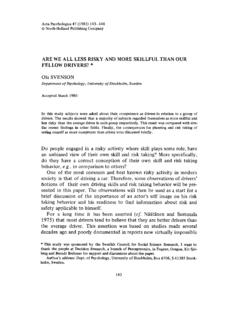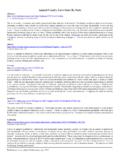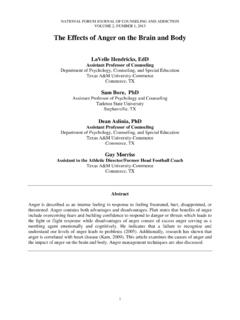Transcription of ANGER MANAGEMENT: DIAGNOSTIC DIFFERENCES AND …
1 LENCHANGER MANAGEMENTANGER management : DIAGNOSTICDIFFERENCES AND treatment IMPLICATIONSHEATHER C. LENCHU niversity of California, IrvineCourts are referring an increasing number of people to ANGER management treat-ment, yet there are very few available guidelines for how to diagnose and treat an-gry people. Indeed, ANGER does not exist as a DIAGNOSTIC category in the purpose of the present study was (a) to determine whether people referred foranger treatment met the DSM-IV criterion for other affective disorders that symp-toms cause clinically significant distress or impairment in social, occupational, orother important areas of functioning, and (b) to determine whether there were sig-nificant DIFFERENCES in the coping and ANGER expression styles utilized by angry ver-sus normal populations.
2 A group of 114 college students and 66 people referred foranger management treatment completed the Life Experiences Questionnaire, theStrategic Approaches to Coping, the Trait ANGER Inventory, and the Revised-AngerExpression Inventory. Results indicate that people in the ANGER management groupand people who scored high on the ANGER inventory demonstrate impairment intheir relationships. There were also DIFFERENCES in the coping styles and ANGER ex-pression styles used by angry individuals compared to those who were low inanger. These findings have practical implications for the diagnosis and treatment ofanger-related and treating individuals with ANGER problems has been anincreasing concern to health organizations, clinicians, and society as awhole.
3 For domestic violence and child abuse cases, courts have begunto refer individuals to ANGER management treatment . A huge demandto treat angry people is placed on therapists by the courts, yet therapistsdo not yet have research-based guidelines for recognizing, diagnosing,treating, or preventing future violence. Because ANGER is the most com-mon precipitator of violence, it is surprising that such a narrow body ofJournal of Social and Clinical Psychology, Vol. 23, No. 4, 2004, pp. 512-531512 Financial support for this paper was provided to the author by the National Institute ofMental Health, National Research Service Award institutional grant, 5T32 correspondence to Heather Lench, Department of Psychology and Social Be-havior, 3340 Social Ecology II, Irvine, CA 92697-7085; E-mail: on ANGER exists (Edmondson & Conger, 1996).
4 Furthermore, de-spite the increased public awareness of ANGER as a problem, no distinctdiagnostic categories for ANGER exist, nor is there adequate research onwhich therapeutic techniques are effective to treat angry patients (Beck& Fernandez, 1998; Browne, 1993; Terjesen, DiGiuseppe, & Naidich,1997).The purpose of the present study was to investigate whether a diag-nostic category for ANGER is warranted and to identify DIFFERENCES be-tween people with potentially damaging ANGER problems and peoplewithout these problems. Two specific goals were pursued. First, the rela-tions between people s score on an ANGER inventory or referral for angermanagement treatment and problems in social, occupational, and ro-mantic relationships were examined.
5 One criterion for affective disor-ders ( , depression and anxiety) in theDiagnostic and Statistical Manualof Mental Disorders-IV(DSM-IV; American Psychiatric Association[APA], 1994) is that the symptoms cause clinically significant distress orimpairment in social, occupational, or other important areas of function-ing. Therefore, if angry people report impairment in these areas, angermeets this criterion for a mood-related disorder. Second, associationsbetween referral to ANGER management treatment or people s scores onan ANGER inventory and coping and ANGER expression styles were investi-gated. Knowledge regarding DIFFERENCES between clinically angrypeople referred for therapy and others in coping and ANGER expressionmay be useful for treatment and early OF ANGERSome theorists believe that ANGER is a maladaptive attempt at copingwith a stressful environment, resulting in greater conflict and personaldiscomfort (Cox, Stabb, & Bruckner, 1999; Novaco, 1975).
6 However, re-cent conceptualizations have focused on ANGER as an adaptive mecha-nism for dealing with obstructed goals and perceived threats (Cox et al.,1999; Stein & Levine, 1989), with healthy ANGER being differentiated fromunhealthy ANGER in terms of how successfully the emotion serves the ba-sic needs of the person (Grieger, 1986). For example, if a person made aquirky remark in an angry response to a coworker s rude comment, pos-itively resolving the situation, then the ANGER response was healthy. Ifthe person punched the rude coworker, thus endangering employment,the ANGER response was some forms of dysfunctional ANGER are situation dependentand acute, such as the example described above, other forms may be re-lated to chronic ANGER .
7 People who are chronically or problematicallyangry are often unable to appropriately deal with stress and thereforeANGER MANAGEMENT513become frustrated, which inevitably leads to increased ANGER (Cox et al.,1999; Edmondson & Conger, 1996; Grieger, 1986). They may become an-gry in situations where it is not a useful emotion and may have difficultysuccessfully resolving the ANGER . Therefore, chronically angry peoplemay become angry quicker and remain angry for longer periods of and ANGER are significant predictors of coronary heart diseaseand poor health (Fava, Anderson, & Rosenbaum, 1990). Furthermore,recent research indicates that people with chronic aggressive tendenciesmaintain poor social relationships (Monnier, Stone, Hobfoll, & Johnson,1998).
8 Because chronic ANGER affects daily life and health, it is likely notserving the basic needs of the person and is therefore sum, it appears that acute or chronic dysfunctional ANGER can beharmful to people, causing impairment in their satisfaction, health, andrelationships. However, research is needed to confirm earlier findingsthat ANGER harms social relationships and to identify other domains,such as coping and ANGER expression styles, in which angry people ex-hibit deficits. These domains may be utilized to diagnose, treat, orprevent ANGER OF ANGER DISORDERSThe current practice is to conceptualize ANGER as a subtype of existing di-agnostic categories.
9 For example, a person who meets clinical criteria fordepression and presents as hostile would likely be diagnosed as havinga depressive disorder with irritable mood. By considering ANGER a com-ponent of other disorders, clinicians may largely ignore the angry pre-sentation of the client and potential problems related to ANGER may gountreated. Instead, the treatment would focus on depression. Often itmay be difficult to distinguish among depression, anxiety, and ANGER be-cause they are frequently comorbid disorders (Endler & Parker, 1990;Silva, 1997).However, there is evidence that ANGER problems frequently exist in in-dividuals without symptoms of anxiety or depression.
10 Fava, Anderson,and Rosenbaum (1990, 1993) describe ANGER attacks, which refer tobrief periods of ANGER out of proportion to what is considered appropri-ate in the situation and accompanied by a feeling of being out of researchers found that patients descriptions of the physiologicalresponses in ANGER attacks were similar to panic attack descriptions,characterized by tachycardia, sweating, flushing, and feeling out of con-trol. However, the patients with ANGER attacks did not report the affectusually associated with panic and did not meet criteria for other estab-lished disorders. Approximately 43-48% of depressed patients also re-ported experiencing ANGER attacks, and these attacks were established to514 LENCHbe separate diagnostically from anxiety or depression, because the mainaffective characteristic was of hostility and ANGER (Fava et al.)












